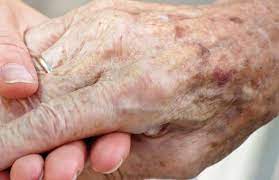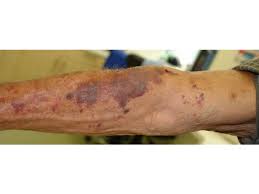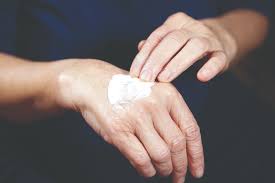Skin tears in older people  A skin tear is an injury that causes the skin to peel back or can result in total skin loss. Older people and new-born babies are at the highest risk. In most people they can cause minor wounds and often bruising, however, they can cause more serious wounds issues. Skin tears mostly occur on the legs, arms, and the back of the hands. Skin tears can become chronic wounds if neglected or treated poorly, damaging the individual’s health and generating significant healthcare costs. Given the ageing of the New Zealand population, skin tears will inevitably increase as a public health problem, so their prevention and management is important. A skin tear is an injury that causes the skin to peel back or can result in total skin loss. Older people and new-born babies are at the highest risk. In most people they can cause minor wounds and often bruising, however, they can cause more serious wounds issues. Skin tears mostly occur on the legs, arms, and the back of the hands. Skin tears can become chronic wounds if neglected or treated poorly, damaging the individual’s health and generating significant healthcare costs. Given the ageing of the New Zealand population, skin tears will inevitably increase as a public health problem, so their prevention and management is important.  Definition of skin tears Skin tears are lacerations that can extend through the epidermis (the top layer of skin) and into – but not through – the dermis, which is the lower layer of skin that contains capillaries, nerve endings, sweat glands and hair follicles. Friction or shear force can cause separation of the epidermis from the dermis, thereby creating a jagged or angular flap of skin. The epidemiology of skin tears Research has found that skin tears account for nearly 55 per cent of all wounds in the elderly. A recent systematic review found incidence rates of skin tears in the elderly, ranging from 2.2 per cent to 92 per cent per annum in long-term residential care facilities and 2.1 per cent among men to 4.6 per cent among women living in the community. A study performed in six long-term care facilities found skin tears in nine per cent of residents. The effects of decreasing hormonal levels on the skin make women more susceptible to skin tears than men. Women’s longer life expectancies exacerbate their higher incidence of skin tears. Causes and risk factors The risk of sustaining skin tear increases significantly as the skin becomes weaker, drier, less elastic, and thinner due to decreased subcutaneous fat, collagen, elastin deposition and sebum gland secretion that comes with ageing.  Japanese research found that photo-ageing, specifically sun damage to the dermis as a result of outdoor lifestyles and occupations, was a risk factor for skin tears. Other risk factors for skin tears:
Research has documented associations between skin tears and age-related factors such as dependency in activities of daily living, sensory loss, limited mobility, use of assistive devices, impaired cognition and medication. Poor nutrition can increase risk by further weakening the skin and reducing its shock-absorbing capacity. A review of nine studies found that the most common characteristics of patients with skin tears were a history of skin tears, impaired mobility and impaired cognition. Healthcare practitioners can also inadvertently cause skin tears when handling elderly patients or removing adhesive bandages and tapes. They can also be inflicted during routine activities such as dressing and bathing, falls, bumping into objects, patient transfers and using wheelchair and other mobility aids. People living with dementia and other mental health conditions can behave in an agitated manner that can increase the risk of skin tears. Prevention The most common-sense recommendations for the prevention of skin tears in the elderly include:
Researchers tested the effectiveness of a twice-daily moisturising regime, compared to ‘usual’ skin care, for reducing the incidence of skin tears in the residents of 14 aged-care over six months. The intervention group received twice-daily application of a commercially moisturizer or their forearms, lower legs, hands and feet; the control group received no standardized skin-moisturising regimen. The intervention group recorded an average of 5.76 skin tears per 1000 occupied bed-days, versus 10.57 in the control group – an almost 50 per cent reduction in incidence. Other ways to look after the skin:
Treatment The first response to a skin tear is to clean the wound with saline solution or warm water and gently pat it dry. If a viable skin flap exists, it should be replaced over the dermis, using forceps or a moist cotton bud before a dressing is applied. New technologies have led to the development of highly effective bandages that create a seal to prevent bacteria and water from aggravating the skin tear. In addition, zinc applied in a paste or bandage has been found to offer protective, anti-inflammatory and antibacterial properties, which promote healing by stimulating cell growth. If any of the following occur, seek medical attention:
(Aged Care New Zealand, Issued 01 2022, pg. 90/91) Comments are closed.
|
AuthorShonagh O'Hagan Archives
July 2024
|

 RSS Feed
RSS Feed